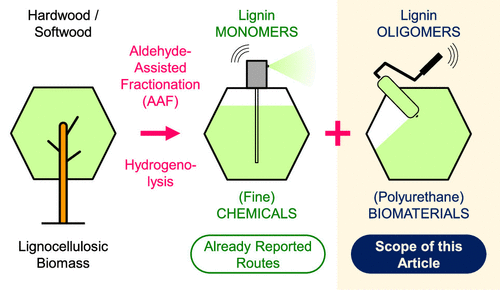当前位置:
X-MOL 学术
›
Biomacromolecules
›
论文详情
Our official English website, www.x-mol.net, welcomes your feedback! (Note: you will need to create a separate account there.)
Aldehyde-Assisted Lignocellulose Fractionation Provides Unique Lignin Oligomers for the Design of Tunable Polyurethane Bioresins.
Biomacromolecules ( IF 6.2 ) Pub Date : 2020-08-26 , DOI: 10.1021/acs.biomac.0c00927 Richard Vendamme 1, 2 , Jean Behaghel de Bueren 3 , Jaime Gracia-Vitoria 1 , Florence Isnard 1 , Mikael Monga Mulunda 1, 4 , Pablo Ortiz 1 , Mohan Wadekar 1 , Karolien Vanbroekhoven 1 , Chloé Wegmann 3 , Raymond Buser 3 , Florent Héroguel 3 , Jeremy S Luterbacher 3 , Walter Eevers 1, 5
Biomacromolecules ( IF 6.2 ) Pub Date : 2020-08-26 , DOI: 10.1021/acs.biomac.0c00927 Richard Vendamme 1, 2 , Jean Behaghel de Bueren 3 , Jaime Gracia-Vitoria 1 , Florence Isnard 1 , Mikael Monga Mulunda 1, 4 , Pablo Ortiz 1 , Mohan Wadekar 1 , Karolien Vanbroekhoven 1 , Chloé Wegmann 3 , Raymond Buser 3 , Florent Héroguel 3 , Jeremy S Luterbacher 3 , Walter Eevers 1, 5
Affiliation

|
Thanks to chemical stabilization, aldehyde-assisted fractionation (AAF) of lignocellulosic biomass has recently emerged as a powerful tool for the production of largely uncondensed lignin. Depolymerization of AAF lignin via ether cleavage provides aromatic monomers at near theoretical yields based on ether cleavage and an oligomeric fraction that remains largely unexploited despite its unique material properties. Here, we present an in-depth analytical characterization of AAF oligomers derived from hardwood and softwood in order to elucidate their molecular structures. These bioaromatic oligomers surpass technical Kraft lignin in terms of purity, solubility, and functionality and thus cannot even be compared to this common feedstock directly for material production. Instead, we performed comparative experiments with Kraft oligomers of similar molecular weight (Mn ∼ 1000) obtained through solvent extraction. These oligomers were then formulated into polyurethane materials. Substantial differences in material properties were observed depending on the amount of lignin, the botanical origin, and the biorefining process (AAF vs Kraft), suggesting new design principles for lignin-derived biopolymers with tailored properties. These results highlight the surprising versatility of AAF oligomers towards the design of new biomaterials and further demonstrate that AAF can enable the conversion of all biomass fractions into value-added products.
中文翻译:

醛辅助的木质纤维素分级分离提供了独特的木质素低聚物,用于可调谐聚氨酯生物树脂的设计。
由于化学稳定作用,木质纤维素生物质的醛辅助分馏(AAF)最近已成为生产大部分未冷凝木质素的有力工具。通过醚裂解使AAF木质素解聚提供的芳香族单体基于醚裂解的理论产率接近理论值,尽管其独特的材料性能,其低聚物馏分在很大程度上仍未被利用。在这里,我们提出了对源自硬木和软木的AAF低聚物的深入分析特性,以阐明其分子结构。这些生物芳香族低聚物在纯度,溶解度和功能性方面超过了卡夫木质素,因此甚至不能直接与这种普通原料进行材料生产。代替,我们对通过溶剂萃取获得的具有类似分子量(Mn〜1000)的卡夫低聚物进行了对比实验。然后将这些低聚物配制成聚氨酯材料。根据木质素的量,植物来源和生物精制过程(AAF与卡夫工艺),观察到材料性能的显着差异,这为具有定制性能的木质素衍生生物聚合物提出了新的设计原理。这些结果凸显了AAF低聚物在设计新生物材料方面的令人惊讶的多功能性,并进一步证明AAF可以使所有生物质组分转化为增值产品。根据木质素的量,植物来源和生物精制过程(AAF与卡夫工艺),观察到材料性能的显着差异,这为具有定制性能的木质素衍生生物聚合物提出了新的设计原理。这些结果凸显了AAF低聚物在设计新生物材料方面的惊人多功能性,并进一步证明AAF可以使所有生物质组分转化为增值产品。根据木质素的量,植物来源和生物精制过程(AAF与卡夫工艺),观察到材料性能的显着差异,这为具有定制性能的木质素衍生生物聚合物提出了新的设计原理。这些结果凸显了AAF低聚物在设计新生物材料方面的惊人多功能性,并进一步证明AAF可以使所有生物质组分转化为增值产品。
更新日期:2020-10-12
中文翻译:

醛辅助的木质纤维素分级分离提供了独特的木质素低聚物,用于可调谐聚氨酯生物树脂的设计。
由于化学稳定作用,木质纤维素生物质的醛辅助分馏(AAF)最近已成为生产大部分未冷凝木质素的有力工具。通过醚裂解使AAF木质素解聚提供的芳香族单体基于醚裂解的理论产率接近理论值,尽管其独特的材料性能,其低聚物馏分在很大程度上仍未被利用。在这里,我们提出了对源自硬木和软木的AAF低聚物的深入分析特性,以阐明其分子结构。这些生物芳香族低聚物在纯度,溶解度和功能性方面超过了卡夫木质素,因此甚至不能直接与这种普通原料进行材料生产。代替,我们对通过溶剂萃取获得的具有类似分子量(Mn〜1000)的卡夫低聚物进行了对比实验。然后将这些低聚物配制成聚氨酯材料。根据木质素的量,植物来源和生物精制过程(AAF与卡夫工艺),观察到材料性能的显着差异,这为具有定制性能的木质素衍生生物聚合物提出了新的设计原理。这些结果凸显了AAF低聚物在设计新生物材料方面的令人惊讶的多功能性,并进一步证明AAF可以使所有生物质组分转化为增值产品。根据木质素的量,植物来源和生物精制过程(AAF与卡夫工艺),观察到材料性能的显着差异,这为具有定制性能的木质素衍生生物聚合物提出了新的设计原理。这些结果凸显了AAF低聚物在设计新生物材料方面的惊人多功能性,并进一步证明AAF可以使所有生物质组分转化为增值产品。根据木质素的量,植物来源和生物精制过程(AAF与卡夫工艺),观察到材料性能的显着差异,这为具有定制性能的木质素衍生生物聚合物提出了新的设计原理。这些结果凸显了AAF低聚物在设计新生物材料方面的惊人多功能性,并进一步证明AAF可以使所有生物质组分转化为增值产品。



























 京公网安备 11010802027423号
京公网安备 11010802027423号